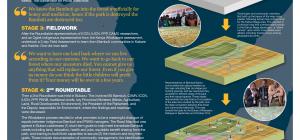Democratic Rebublic of Congo
3D Mapping and Whakatane process in Kahuzi Biega, DRC
The Whakatane Mechanism was developed by IUCN in 2011 “to address and redress the effects of historic and current injustices against indigenous peoples in the name of conservation”. It is a consensual approach to generating frameworks that enable indigenous communities and conservation authorities to work together to protect their rights and the environment. Its success depends on conservation and government authorities recognising that indigenous peoples can become effective partners in conservation when their right to help protect their lands is implemented.
The Kahuzi Biega Whakatane Assessment, during September and October 2014, was the third such assessment to be piloted by IUCN across the world. The first two pilot Whakatane Assessments took place in 2011 and 2012, in Mt Elgon, Kenya and in Ob Luang National Park, Thailand. The results of all the assessments will be presented at IUCN’s World Parks Congress in Sydney in November 2014 to help shape the future of conservation.
The multi-step process in Kahuzi-Biega included:
- 3D Mapping: Over 21 days Bambuti from the main clan groups around Kahuzi constructed a 3D map of their territory.
- The 3-D map was presented at the first meeting between the Bambuti and PKNB, local authorities, IUCN and ICCN. As well as demonstrating their lands and knowledge, it reflected their cultural and social dependence on their forests. The conservator for PKNB noted: “We know the Bambuti go into the forest unofficially for honey and medicine, hence if the park is destroyed the Bambuti are destroyed too.”
- Fieldwork: After the round-table, representatives of ICCN, IUCN, FPP, CAMV, researchers, and an Ogiek indigenous representative, from the Kenya Whakatane assessment, undertook a three-day field assessment to learn from Bambuti communities in Kabare, Bunyakiri and Kalehe. One old man said: “We want to have our land back where we can live according to our customs. We want to go back to our forest where our ancestors died. You cannot give us anything that will replace our forest. Even if you give us money.”
- A second round-table was held in Bukavu, where the findings and road map were discussed. This involved 85 Bambuti, CAMV, ICCN, IUCN, FPP, PKNB, traditional chiefs, key Provincial Ministers (Mines, Agriculture, Land, Rural Development, Environment), the President of the Parliament, and the deputy responsible for the environment.
The Whakatane process resulted in what promises to be a meaningful dialogue between indigenous Bambuti and PNKB managers. The road map addresses short-term goals to help meet immediate Bambuti needs including land, education, health and jobs, equitable benefit sharing from the park, and training to build their capacities to secure the medium and long-term goals. These include documenting community management, identifying park periphery lands to hand back to communities, and allowing Bambuti collective land ownership, resulting in modern, rights-based conservation.
The key sticking point in these discussions is continued disagreement over the possibility that Bambuti could ever regain formal recognition for their rights inside the existing boundaries of the PKNB. The success of DRC’s community conservation approach will be judged by its ability to enforce communities’ rights to manage their traditional territories and better protect their environment.
